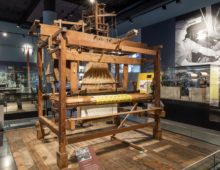Tagged with Protest
Resource : Welsh project digitises documents from the Newport Chartist Uprising of 1839
May 7, 2019 - Richard Moss
This fascinating project, which launched in 2016 in Wales, has seen volunteers working to transcribe more than 3,000 important documents gathered together shortly after the famous Newport Chartist Rising of November 3rd and 4th 1839. Unlocking the Chartist Trials uses online volunteers to transcribe the court records relating to the famous Rising, which is cited […]
Resource : Silhouette of Thomas Muir
Thomas Muir was a radical, who campaigned for political reform in Scotland. He was eventually accused of sedition and transported to Australia, following one of the most notorious and controversial trials in Scottish history. He became known as the father of Scottish democracy and one of Scotland’s five ‘political martyrs’.
Resource : Queen Marie Antoinette of France and two of her children walking in The Park of Trianon
Marie Antoinette was the wife of the last King of France, Louis XVI, before the French Revolution overthrew the monarchy. She was known for extravagance and indulgence, and was despised by the people of France. She came to symbolise the Ancien Régime – a long-standing system where the monarchy, aristocracy and Catholic Church held absolute power and privilege over ordinary people.
Resource : The Battle of Vertières
In the late 1700s, the western part (St. Domingue) of the Caribbean island of Hispaniola was under French colonial rule. It had long been a major centre of sugar production on plantations using enslaved African labour. In 1791, Toussaint Louverture led the first – and only – successful uprising of slaves, in St Domingue. After a series of bloody conflicts and traumas with European colonial powers, St Domingue was renamed Haïti and became the first independent Black republic in 1804. These events became known as the Haitian revolution and played an important role in the decline of the Transatlantic slave trade. This lithograph depicts the Battle of Vertières in 1803, the final engagement between Haiti’s revolutionaries and Napoleon’s French forces.
Resource : Captain Swing letter to Mr Biddle, farmer, High Wycombe
In the 1700s, work was localised and family-orientated, largely agricultural and driven by hand and horse labour. But innovations in steam power and the design of machinery in the late 1700s and early 1800s transformed manufacturing and the way people lived and worked. In the 1820s and 30s, factors such as increasing industrialisation, poor harvests and, specifically, the introduction of the threshing machine meant farming wages were low, working conditions poor and unemployment high. Agricultural workers in the South and East of England protested in what became known as the Swing riots (or agricultural labourers’ risings).
Resource : Theobald Wolfe Tone
Wolfe Tone was a founder of the United Irishmen and a leading figure in the fight for Irish independence from British rule. In 1798, Tone led the United Irishmen in a major uprising, hoping to begin a nationalist and republican revolution in Ireland with the support of French troops.
Resource : Skelmanthorpe Flag
The 1800s saw a series of protests and uprisings in Britain, as people campaigned against slavery, unjust taxes and laws imposed by the government and in support of fair wages, the right to vote and to have their voices heard in parliament. Protest flags, posters and banners carrying radical slogans were a popular way for campaigners to get their message across at marches and rallies, and to cooperate without endangering individuals. The Skelmanthorpe flag was created in secret, in Huddersfield, initially to honour the victims of what became known as the Peterloo Massacre, in 1819.
Resource : Jeremiah Brandreth pot
The Pentrich Rising was a small armed rebellion initiated by political radicals in the Midlands in 1817, which they hoped would spread far and wide and bring about revolutionary changes to the structure of government and society.
Resource : Rebecca and her daughters
In the late 1830s and early 1840s, a series of riots took place in south and mid Wales. Male farmers and labourers – many of them dressed in women’s clothes – rioted in protest against unfair laws and taxes, low wages and toll roads. The rioters called themselves ‘Rebecca’s daughters’ and their actions became known as the Rebecca riots.
Resource : Thomas Clarkson’s campaign chest
Between the 1500s and early 1800s, millions of Africans were kidnapped, sold and transported to the Americas to work as slaves, in unimaginably cruel conditions, on hugely profitable plantations, producing sugar, tobacco and other commodities. These plantations were largely owned by Europeans and Euro-Americans. Britain grew rich on the profits from this transatlantic slave trade, which were reinvested into other economic sectors. Only in the late eighteenth century did public opinion slowly begin to turn against the trade in Africans, and campaigners for abolition used every way they could to bring the issue to people’s attention in Europe.


